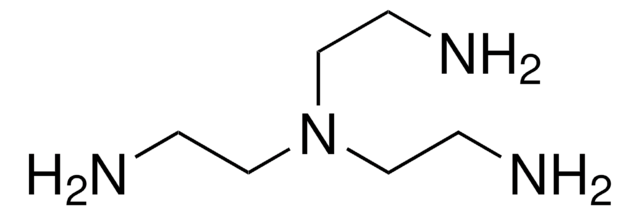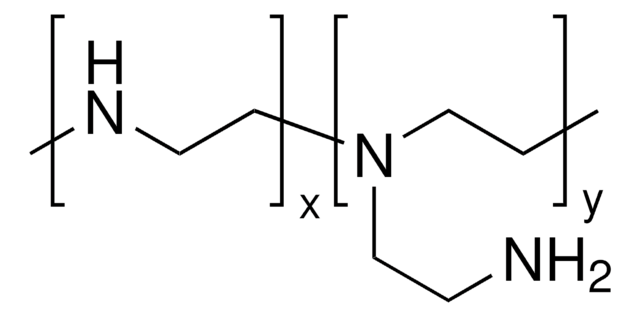408719
Polyethylenimine, branched
average Mw ~800 by LS, average Mn ~600 by GPC
Synonym(s):
PEI, ethylenediamine branched
About This Item
Recommended Products
form
viscous liquid
Quality Level
mol wt
average Mn ~600 by GPC
average Mw ~800 by LS
refractive index
n20/D 1.5240
density
1.050 g/mL at 25 °C
InChI
1S/C2H8N2.C2H5N/c3-1-2-4;1-2-3-1/h1-4H2;3H,1-2H2
InChI key
SFLOAOINZSFFAE-UHFFFAOYSA-N
Related Categories
General description
Application
Bamboo charcoal impregnated with PEI can be used as a CO2 adsorbent. Numerous amino groups present in PEI can react with CO2 due to acid-alkali interaction and enhance the adsorption capacity of bamboo charcoal.
It can also be used to prepare cross-linked water-soluble polymers with high coordination capabilities towards organic drug molecules.
Features and Benefits
- Branched PEI has better complexation and buffering capacity.
- High ion exchange capacity and affinity toward proteins.
- SignificantDNA transfer efficiency.
Physical form
Signal Word
Danger
Hazard Statements
Precautionary Statements
Hazard Classifications
Acute Tox. 4 Oral - Aquatic Chronic 2 - Eye Dam. 1
Storage Class Code
10 - Combustible liquids
WGK
WGK 3
Flash Point(F)
356.0 °F
Flash Point(C)
180 °C
Personal Protective Equipment
Choose from one of the most recent versions:
Already Own This Product?
Find documentation for the products that you have recently purchased in the Document Library.
Customers Also Viewed
Articles
Professor Yoshiki Katayama (Kyushu University, Japan) discusses recent advances in drug delivery systems and strategies that exploit the EPR effect, with a special focus on stimuli-responsive systems based on novel materials.
Gene therapy has become one of the most discussed techniques in biomedical research in recent years.
We present an article that discusses two applications in particular; first, using these layers as polyelectrolyte membranes to control permeability.
Our team of scientists has experience in all areas of research including Life Science, Material Science, Chemical Synthesis, Chromatography, Analytical and many others.
Contact Technical Service










